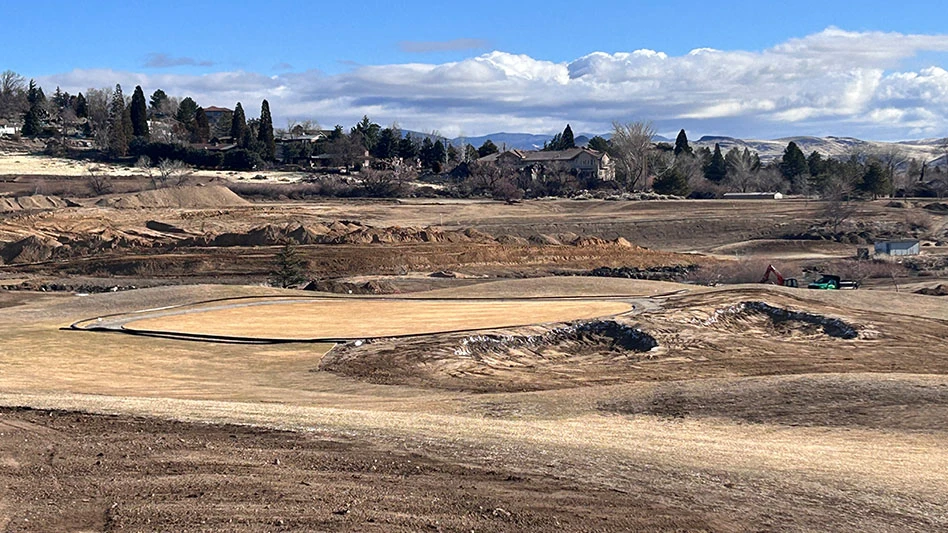In a buyer's market, owners need to make sure finances are in order and properties are well maintained.
In addition to being co-owner of a golf car distributor company, a 36-hole golf facility and a golf real estate development company, Walt Lankau and four partners used to own Sterling National Country Club in Massachusetts.
But something had to go, partly because Lankau was trying to simplify his life.
“I’m not in the investment mode right now,” says the 64-year-old.
So Lankau and his partners decided Sterling National – a private course designed by Michael Hurdzan that opened in 1991 – was what had to go. The group came to a consensus, and about nine months later, sold it to Forewinds Hospitality for an undisclosed price. Lankau and his partners listed the facility with a golf course broker, which brought in potential buyers.
“One of the groups (Forewinds) decided they liked it, and they made us an offer, and we worked it out,” Lankau says. “We received an acceptable deal, obviously, because we went through with it.”
In many ways, selling a golf course is similar to selling a home. It needs to have curb appeal and be well maintained, and proper record-keeping must be in order. It also helps to have a professional broker help manage the sale.
Market conditions
In the current golf market, selling a property isn’t as easy as it was 10 years ago, when the industry was experiencing exceptional growth. The National Golf Foundation’s research indicates there are more than 16,000 courses in America, but no one knows how many of them are for sale. However, brokers claim the old saying, “Every golf course is for sale for the right price,” is true now more than ever.
Steve Hughes, a licensed broker with Kansas City, Mo.-based Hughes and Co., conducts golf course appraisals and says the market is a buyer’s one.
“There are a lot of golf courses on the market,” he says. “Nobody knows how many, but certainly hundreds and perhaps thousands. Most likely it’s hundreds. But 10 years ago, you could hardly find a course for sale.”
Hughes is aware of 12 courses for sale in Missouri, which is 4 percent of the state’s 292 facilities. Although Hughes says there isn’t a way to determine how many courses are for sale nationwide, he estimates 8,000 are potentially for sale at any one time. Of those, only 7 percent are on the national market, however. The rest appeal to local buyers or developers.
Hilda Allen’s Hilda Allen Realty, which specializes in selling golf courses, has closed 214 deals totaling more than $750 million since 1991.
“There is a tremendous amount of courses for sale, probably more than in the hundreds,” Allen says. “The major corporate level is more than 100. ClubCorp has its whole portfolio on the market, except Pinehurst. I just sold three during the past year for Meadowbrook Golf.”
At press time, ClubCorp had a deal pending to sell its inventory of golf courses to KSL Capital Partners for a reported $1.8 billion.
According to NGF, 124.5 new 18-hole courses were built in the United States in 2005, which is a decline from the high-water mark of 398.5 built in 2000. In fact, the number is reflective of the amount of activity in the mid-1980s, a low mark during the past few decades and the beginning of the latest golf course development boom. Also, 93.5 18-hole facilities closed in 2005, according to NGF. Of those, 54 percent were for real estate development.
“So many owners are forced to sell because we’ve overbuilt and golf participation is steady to declining during the past three or four years,” Hughes says. “Many courses aren’t making their debt payment to the bank to stay open. Many buyers are real estate developers who want to enter the commercial market.”
NGF numbers indicate 61 percent of the new golf courses built in 2005 were tied to real estate development, an increase from 35 to 40 percent in the peak years during the late 1990s.
“Many of them are happy to hang on to it and try to make it go for five years,” Hughes says. “But their safety net is that they have this land that’s worth so much per acre.”
Hughes says potential buyers of golf courses realize the land on which the courses sit is worth as much as the course itself, so more potential buyers are developer types because they want to develop now or in the future after they evaluate the market.
“We have a stable of buyers looking for courses, and about a third of them are golf pros who want their own course,” Hughes says. “One third are developers looking to buy ground that just happens to be a golf course, and the other third are corporate golf-type entities.”
Larry Hirsch of Golf Property Analysts in Harrisburg, Pa., believes there are enough properties on the market to keep prices somewhat depressed. But he doesn’t see many courses being bought for purposes other than golf.
“A lot of ours that are for sale will stay golf courses,” Hirsch says. “Right now, developers aren’t as aggressive as they’ve been because the housing market is slowing.”
Yet, Allen doesn’t believe the housing bubble is bursting, especially in the South and Sun Belt. She cites interest rates that, in October, were at a six-month low.
“You can’t just arbitrarily rezone,” she says. “There were a little more than 100 courses throughout the country that were redeveloped. Out of the total, that’s not too much.”
Get it ready
With the market conditions what they are, let’s imagine you’re the owner of a course who wants to sell, regardless of the current business climate. How can you get the best price for the facility in a market that favors buyers? Before anything else, check your records.
“First of all, I would have good, easy-to-read financial statements,” Hirsch says. “It’s a cash business, and as such, many courses’ financial statements don’t accurately reflect the business they’re doing. I’d suggest cleaning that up for a year or two, so your statements reflect your operation. No one will buy a golf course based on what you say it makes unless you back it up with financials.”
It’s paramount to have all paperwork in order, Allen says.
“You need complete disclosure of income and expenses for the last three to five years and what you spent on capital improvement,” she says. “And you need patience.”
Hughes advises tracking revenue.
“If you put money in your pocket, it’s tough to sell,” he says.
Owners also need an updated golf course survey, an environmental report, a list of all equipment and a title for the real estate, Hughes says.
“Sometimes, owners get their surveys and environmentals and get rude awakenings when a tee box is on someone else’s ground or a fuel storage tank has been leaking,” he says.
Keeping up with repairs is important, too, Allen says.
“Do all the repairs that need to be done on buildings,” she says. “Make it look like you’re in business. You have to operate until you sell it. Don’t stop spending money on it and expect to get top dollar.”
Hughes agrees.
It needs to be in good shape – you can’t let the course get ratty, with weeds and bare spots,” he says. “It’s like a house. You want it to look good.”
When Lankau and his partners had Sterling National on the market, he says they kept the course well maintained.
“We never, ever said, ‘We’re selling, let’s start to skimp.’ That’s not the way we operate,” Lankau says. “You end up paying in the long run because buyers these days are sophisticated and they will negotiate it in the end if you let it run down.”
Hirsch says keeping a course well maintained is important, but one also must consider the nature of a golf course and its location.
“You have to understand the market that’s going to be attracted to the property,” he says. “Some courses, because of their location, gross revenue or quality, are attractive, or not, to certain segments of the market. Some buyers say, ‘I only want to be in a major market with half a million and gross revenue of a minimum of $2 million,’ so you eliminate certain courses. Those that don’t meet that standard are more likely to be bought by local buyers, not national ones.”
Hirsch, who conducts between 50 and 100 appraisals annually, says they’re an integral part of the selling process.
“You approach it like any other appraisal assignment – you identify the appraisal problem and learn about the property,” he says. “The difference between golf courses and other properties is golf courses aren’t just real estate, they’re a business. If you don’t understand that, you’ll have issues.”
Other factors, such as management issues, weather and type of course affect the process, too, Hirsch says. That’s why he says it’s important to pick the right appraiser when selling a golf course.
“It takes a real understanding of what it is you’re appraising,” he says. “That’s where I see big problems – guys who don’t understand golf courses or guys who play golf but don’t understand what they’re appraising. They don’t even understand what it’s like to be a consumer. You have to have someone who understands golf.”
Better business
In the end, though, it might not be enough to have good record-keeping and a well-maintained facility. To feed the bottom line, you might have to go the extra mile.
“In most cases, sellers aren’t getting what they’re asking for,” Allen says.
She says the industry as a whole, and owners specifically, need to boost business by increasing the number of golfers and rounds at their facilities.
“In the South, we’re up – it’s been a little healthier for the past 18 months,” she says. “No hurricanes helps. It appears we’ve had a great season in the Southeast, and the Mid-Atlantic is up a little bit.
Because the market is overbuilt, the industry has to let the absorption of less competitive golf courses continue to return to a productive market, Allen says.
“We’re at a saturation point,” she says. “We have to get mom and the kids out there with dad. Baby Boomers need to be playing more than twice a year.”
Allen says she’s worked with owners recently who really understand how to sell the sport.
“We all can’t be Michelle Wie and Tiger Woods,” she says. “We need to make it fun and affordable. We need something else to do while we’re there besides play golf – fitness centers, day-care, walking trails and restaurants are needed. We need a good family atmosphere. If it’s only for daddy, it’s not gong to work. We need to make it a family affair.” GCN
T.R. Massey is a freelance writer based in Columbus, Ohio. He can be reached at trm@columbus.rr.com.
Seller's checklist
Make sure your business is in order before putting your golf course on the market. Here’s a list of items to have updated and handy:
• Historical rounds, paying and nonpaying/member (four to five years)
• Historical green fees, tracking increases
and decreases
• Current membership roster/annualized monthly dues billing
• Allocation of ownership payroll
• Allocation of pro shop income and expenses
• Number of members (annually, for four years), including those who left and joined each year
• Current deferred maintenance, if any
• Equipment list (course and clubhouse)
• Title report (legal, easements, title, taxes, etc.)
• Land survey (ALTA)
• Floor plans and golf course plans
• Club documents, articles of incorporation, bylaws
• Copies of leases (equipment, carts)
• Other agreements, licenses, permits
• Any homes association documents/restrictions on redevelopment
• USGA Green Section reports (agronomic audit)
• Environmental Phase 1 audit
Source: Hughes & Co.
Get curated news on YOUR industry.
Enter your email to receive our newsletters.
Explore the November 2006 Issue
Check out more from this issue and find your next story to read.
Latest from Golf Course Industry
- Atlanta Athletic Club approves funding for master plan
- PBI-Gordon introduces new field development team
- The Cabot Collection announces move into course management
- Carolinas GCSA raises nearly $300,000 for research
- Advanced Turf Solutions’ Scott Lund expands role
- South Carolina’s Tidewater Golf Club completes renovation project
- SePRO to host webinar on plant growth regulators
- Turfco introduces riding applicator






